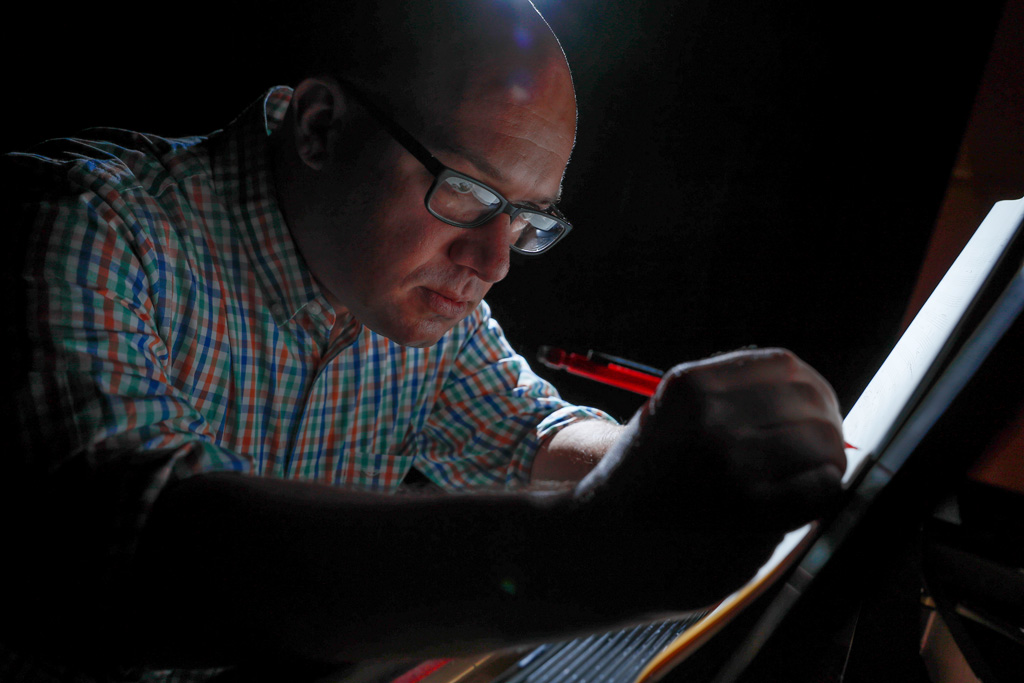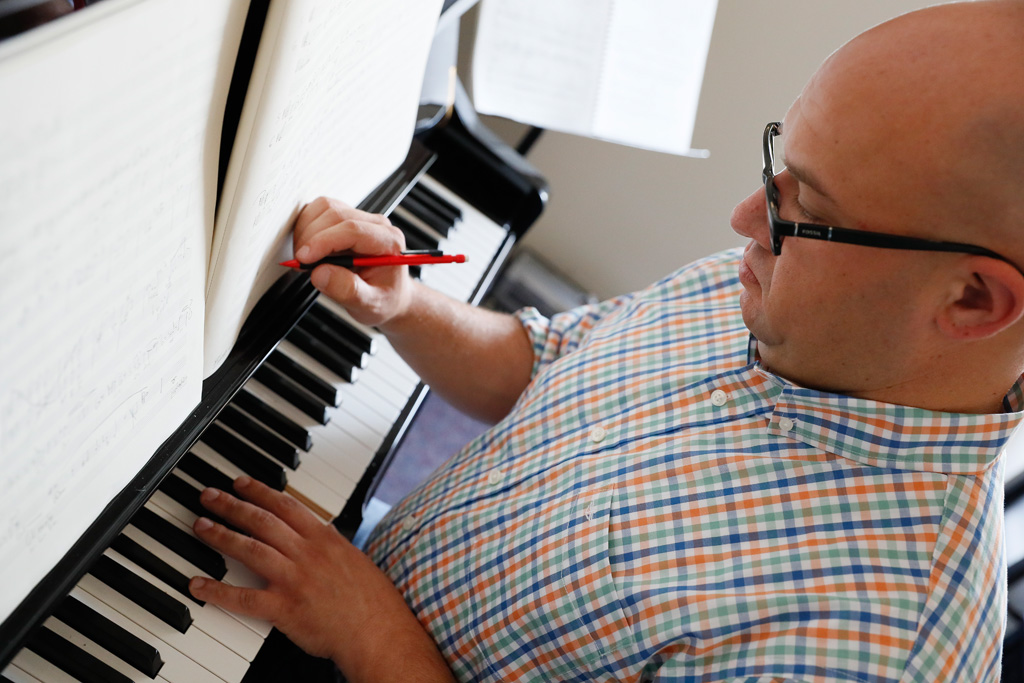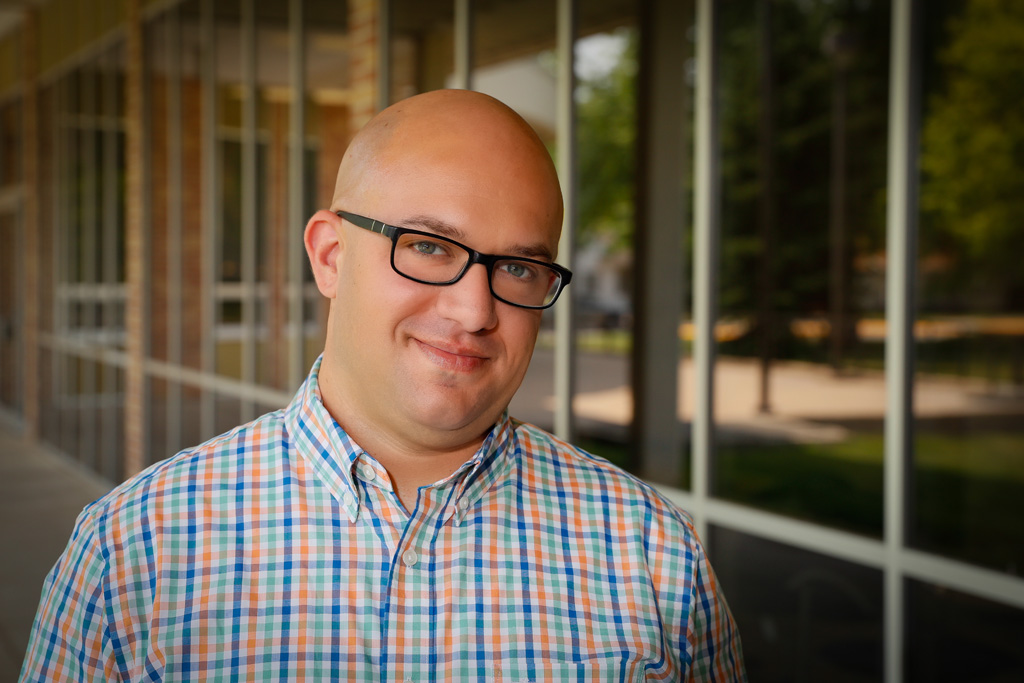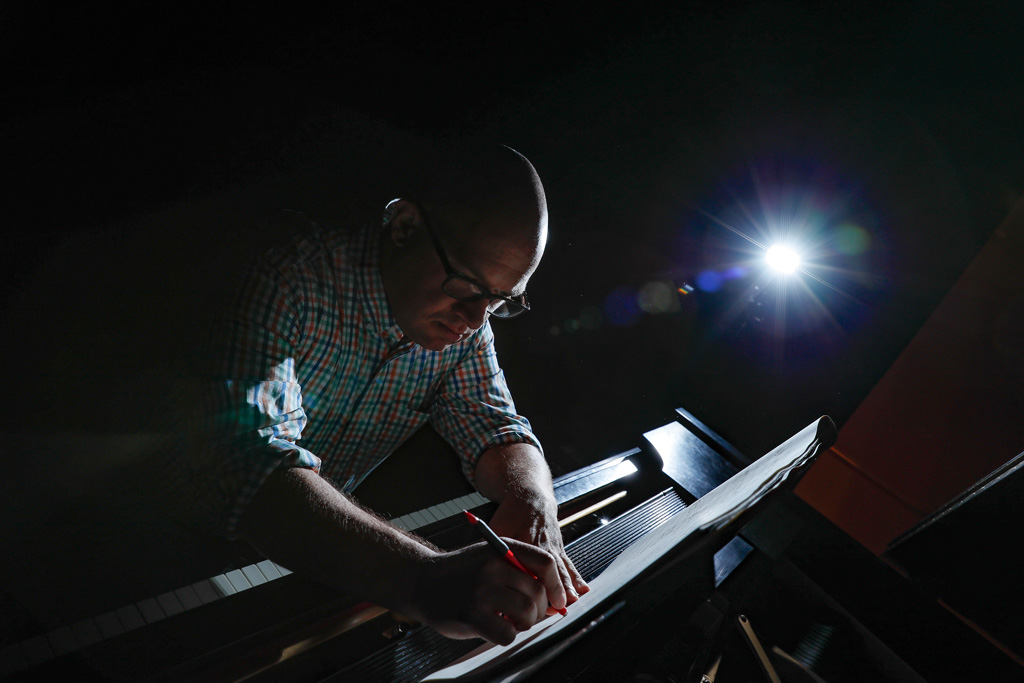It’s hard to say when the music starts, exactly. Opening notes insinuate themselves on the listener, coming into focus as if emerging from a fog. Sounds blink in and out of existence in the space above a low rumble that builds into ripples of musical prose.
Listening to Anthony Donofrio’s “Between Event and Crisis” is a bit like chasing fireflies on a summer evening, both exhilarating and peaceful. Or, maybe it’s more pensive, like solving a riddle.
Sure, Donfrio says. Either way. No problem.
Donofrio sees composition as creation, not interpretation. For him, “Between Event and Crisis” is a piece of depth. A vibraphone solo is at the top, with other percussion taking the middle and the bass drumming at its core. In it, he sees the same non-linear, layered structure he discovered in David Foster Wallace’s novel “Infinite Jest.”
“Do I expect (an audience) to realize that? Absolutely not. That’s the way I was looking at it as I was making it, and that’s good enough for me. That’s all I’m worried about.”
An assistant professor at the University of Nebraska at Kearney, Donofrio blends an interest in literature and painting with his own art by translating compositional techniques from those forms into the language of music. His focus is solely on technique and structure, rather than creating meaning or eliciting emotion from his audiences.
“It’s not about the emotion, it’s not about the story, it’s not about anything programmatic or extramusical, it’s about the technique. It’s about the craft. That’s where I’m comfortable,” he said.
His approach has earned Donofrio significant recognition, including dozens of commissions and acceptance into numerous music festivals. He was chosen for a composer workshop hosted by SEM Ensemble in New York, and was one of only seven composers accepted to the 2016 Bowling Green New Music Festival, an important Midwest event for New Music.
In 2014, his first year at UNK, Donofrio secured grants that expanded the university’s New Music Series and Festival.
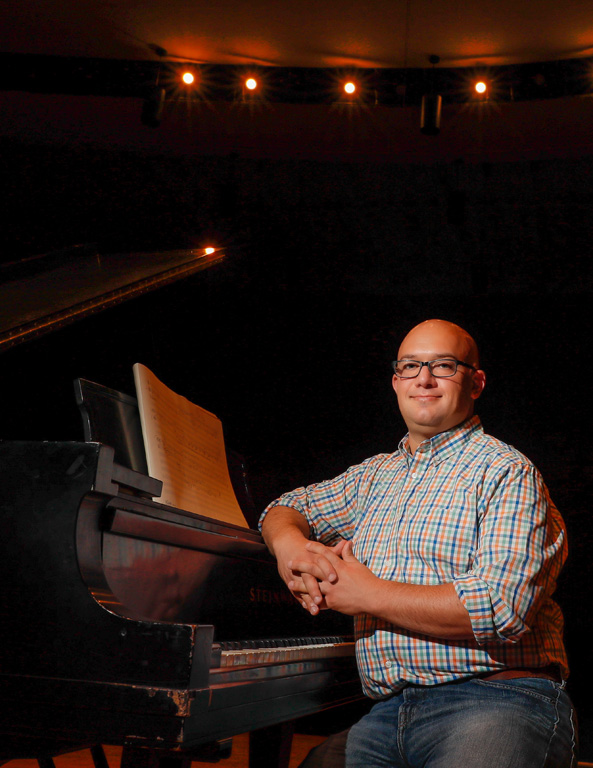 Pearl Jam, Nirvana, Gustav Mahler
Pearl Jam, Nirvana, Gustav Mahler
Reaching this point in his career has meant learning to listen to his own instincts and voice.
Donofrio said he’s been composing since he was a freshman on his high school’s drum line.
“I do not have a taste for marching band music now, and I haven’t since I was about 19,” he said. “Interestingly enough, the thing that got me into writing music was I was in the drum line in marching band because that’s what you had to do, and I wrote drum cadences.”
By the time he finished high school, Donofrio knew he wanted to teach music, but he didn’t want to conduct a band. A music composition major seemed like an obvious choice, but his band director discouraged it, saying he’d “never get a job.”
It wasn’t until he signed up for classes at Kent State University, and noticed all the courses in music theory, that Donofrio realized he wanted to be a college professor.
At first, Donofrio’s compositions took a cue from Gustav Mahler, one of his favorite composers. Even through high school, if Pearl Jam or Nirvana wasn’t on his stereo, it was a Mahler symphony.
“One of the big reasons I gravitated so much toward Mahler was I found that I enjoyed the massive, expansive pieces,” Donofrio said. The shortest Mahler symphony is about 50 minutes.
“Also, his pieces are on a grand scale. The eighth symphony is called the Symphony of a Thousand for a good reason. There are two choirs, eight soloists, and a massive, massive, orchestra. So just that extreme I felt a liking toward.”
Donofrio describes the music he wrote until the end of his doctoral program as a “loud, bombastic, aggressive style.” It was also programmatic, using musical passages to tell stories and symbolize ideas.
“I had written a piece one time where I had all these motives that were assigned to different emotions and different meanings. So this means sadness, and this means happiness, this means that person – way too many things. And it was in four sections, and the four sections were based on four different emotions. And it was going to be wonderful. Everybody was going to walk out in tears.”
Nothing went as planned. Wrong notes, missed lighting cues, and a final whistle intended to symbolize memory fading off that just never happened.
“There were all these musical things that had to happen for these extramusical things to be understood, and if the musical things failed, then the extramusical things failed, and that was the first realization that maybe programmatic music is a dumb idea,” Donofrio said. “The art is music. Not drama, not theater, not literature. Stories are meant to be told through words. My material is sound. Why am I trying to portray all this extra stuff, and not worrying about the sound of it?”
A new direction for his music came when a percussionist friend told him about Morton Feldman. A 20th century composer, Feldman was known for music inspired by the art of abstract painters such as Philip Guston and Mark Rothko.
But it wasn’t the subject, the feeling or the “meaning” of those paintings Feldman captured in his music. It was the technique and often the compositions.
Donofrio explained the process using the example of Feldman’s interest in Turkish rugs. Where a casual observer might see only a solid swath of blue in a rug, Feldman might study the dying technique, discover myriad spots of different blue tones blended into a mass, and decide to use a similar technique for a piece of music.
“What Feldman did was say ‘Ok, I’m going to take the same rhythmic passage, and I’m going to repeat it seven times, but I’m going to make it slightly different each time.’ Feldman’s not trying to get you to envision the Turkish rug, he’s taking that (technical) idea.”
Even better, from Donofrio’s perspective, was that Feldman wrote extremely long compositions.
“I realized you can make these expansive, beautiful pieces without having to be loud about it, and programmatic about it, and dramatic about it,” he said. “It was exactly what I needed at exactly the right time. I can sit and just listen to beautiful sounds for four and a half hours, and I don’t have to make any assumptions, and I don’t have to make any connections, and I can just get deeper and deeper into the sounds.”
Donofrio began thinking about his own interest in literature. Could he take musical inspiration from the compositional techniques used in novels? He began by reading James Joyce’s “Ulysses.” The day after he finished it, he started “Gravity’s Rainbow,” followed by many others. He immediately found techniques he wanted to try.
“Infinite Jest,” for example, offered a story without a clear beginning or end; just a window into the much larger world Wallace’s characters inhabit. And rather than building to a climax, the story delves deeper into their world, expanding readers’ understanding. That lent him the form for “Between Event and Crisis.”
One of Donofrio’s longer works, “V,” uses the circular structure of Joyce’s stream-of-consciousness novel “Finnegans Wake.”
The only problem with his new musical style, Donofrio said, was that he found it halfway through his doctoral dissertation. Though he tried to rearrange the music to reflect his new influences, he said he’s been much happier with the work he’s produced since.
Donofrio describes his process as finding a shape for the music, and those shapes are often suggested by literary references. When asked to write something very short, for example, it brings to mind the short story form, and writers such as Raymond Carver who make every word count.
Longer pieces call for the more intricate structure of a novel, or a complex painting such as Rothko’s.
Donofrio knows his approach to composition isn’t universal, and sometimes finds himself debating other composers who see emotional reaction as key to a composition’s success.
“I’m happy that I went that way because I find it much more interesting to experiment with things like time, and really try to understand. For example, if I have a six-minute piece, six minutes has a much different personality than an 80-minute piece. Sure there are things you can do in 80 that you can’t do in six, but there are things you can do in six that you can’t do in 80, just because of the difference in the way those minutes pass.”
Breaking down resistance and building awareness of contemporary and experimental music is one of Donofrio’s goals for the New Music Series and Festival. While the festival has been at UNK for 15 years, Donofrio introduced several changes to increase its profile.
“The way the old New Music Festival went was you mailed in a score, mailed in a $20 check, and the pieces were selected on the basis of the available performers,” Donofrio said. He used a university seed grant to drop the entry fee, made all submissions electronic, and put a greater emphasis on the quality of the work.
The 2016 festival drew 185 submissions, up from only 26 the year before.
Concerts are also now streamed online, which Donofrio said improves the experience for both composers and student musicians. “As soon as the 3 p.m. concert on Saturday was over (this year), a composer was online congratulating the student performer,” he said. “So a student is getting a personal e-mail from a nationally-known composer, saying ‘thank you for playing my piece.’”
The grant also funded the New Music Series, which has hosted nationally-known performers such as pianist Karl Larson and the Quince Contemporary Vocal Ensemble.
Response from the community, and especially students, is growing stronger.
“The students really get into (the concerts),” Donofrio said. “In the community, we’re getting there. There are community members we see at every single event.” Donofrio has even secured a commission from the Kearney Area Symphony Orchestra, and was recently asked to write music for the university’s bell tower.
In future years, Donofrio said, he hopes to further blend the festival and concert series, so that the festival becomes an end-of-series celebration. Grown into a more prominent event, it could work with Omaha’s Under the Radar festival and gain recognition as an outlet for today’s composers.
“It would be great if right in the middle of the country there was this (showcase) for new music. That’s kind of a long-term goal. We’ll see if it gets there,” he said. But in the meantime, “We’re showing composers from California, composers from Chicago, composers from New York, that it may not be big, but there’s a strong New Music thing going on here.”
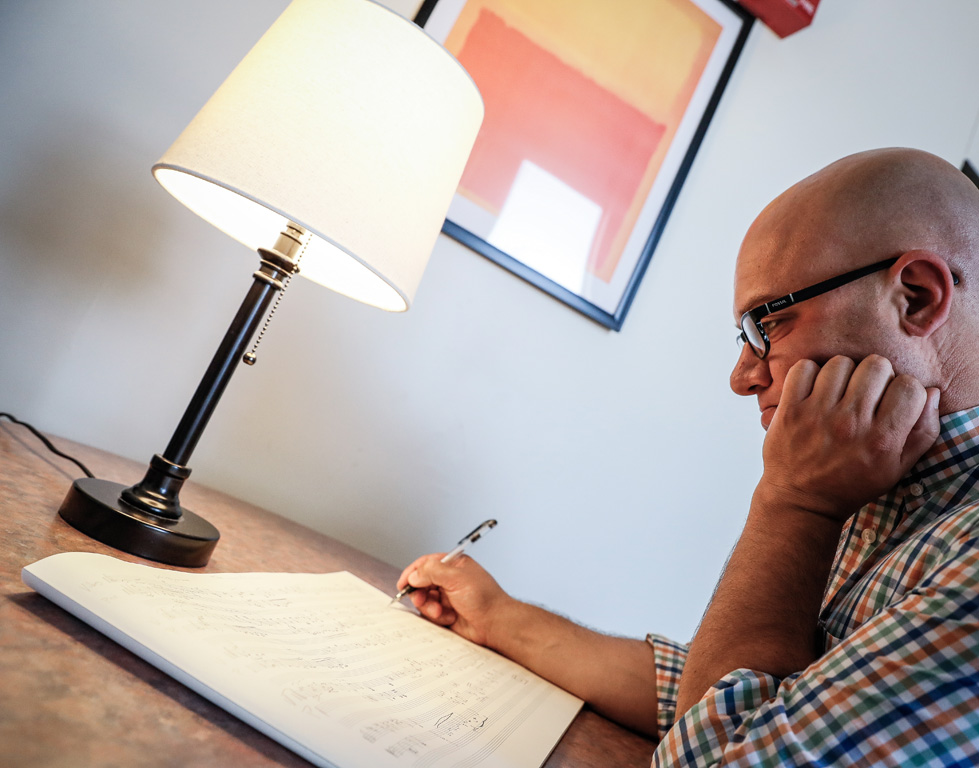 ANTHONY DONOFRIO
ANTHONY DONOFRIO
Title: Assistant professor, Composition and Theory
College: Fine Arts and Humanities
Education: Ph.D., Music Composition, University of Iowa, 2011; Master of Arts, Music Composition, Kent State University, 2007; Master of Music, Percussion Performance, Kent State University, 2005; Bachelor of Music, Music Education, Kent State University, 2003.
Years at UNK: 2
Career: Assistant professor of music, Kent State University, 2011-2014.
Hobbies/Interests: Book collecting, literature, running, chess, cooking.
Honors/Awards: International Academy of Music Excellence in Composition Award, 2011; Seed Grant for UNK New Music Series and Festival, 2014.
Areas of research/specialization: Music composition, Music theory, Private Composition Lessons, New Music Ensemble, Sight Singing/Ear Training, Form and Analysis, Music History/Theory Review, Music Analysis, History of Twentieth Century Music.
Courses taught: Music Fundamentals.
Personal websites: https://donofrio-music.com/ and https://soundcloud.com/anthonydonofrio
Recent Events:
• “Piano Trio,” Selected for S.E.M. Ensemble 2016 Composer Readings.
• “I for Solo Piano,” Commissioned by Amy O’Dell.
• “Essay for Voices,” Performed by Quince Contemporary Vocal Ensemble on its 2015-16 tour.
• “Voratio secreta,” Commissioned by Chamber Cartel, performed on its 2015 tour.
-30-
